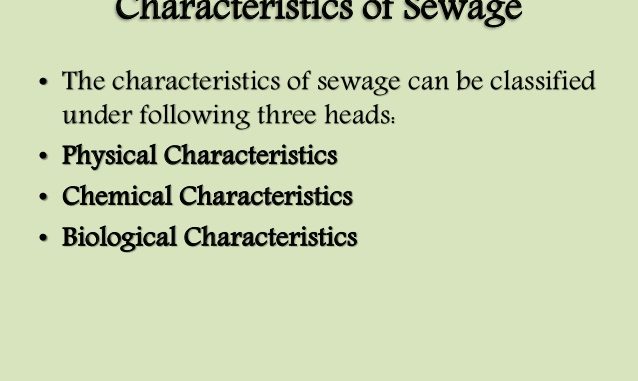
Characteristics of sewage
I. Physical characteristics of sewage:
1. Temperature:
- Temperature of sewage depends upon season. However temperature is slightly higher than that of ground water.
- High temperature of sewage is due to evolution of heat during decomposition of organic matter in sewage.
2. Color:
- Color of sewage indicates its strength and age.
- Fresh domestic sewage is grey in color but septic sewage is dark in color
- When industrial effluent is mixed it give characteristic color to sewage
3. Odor:
- Fresh domestic sewage is almost odorless.
- Septic or stale sewage is putrid in odor which is due to generation of H2S during anaerobic decomposition of organic matters.
- When industrial effluent is mixed, it give characteristics odor to sewage
4. Turbidity:
- Sewage is highly turbid.
- Turbidity of sewage is due to dissolved substances, colloidal matters, suspended solids and microbial cells.
II. Chemical characteristics of sewage:
1. Organic matter:
- In general sewage contains large amount of organic matters. However amount of organic matter depends on types and condition of sewage.
- Organic matter in sewage may be found in the form of dissolved substances, colloidal matter, suspended or sedimented form.
2. Chloride:
- Human beings discharge large amount (8-15gm/day) of chloride in the form of NaCl, especially through urine and sweat. So domestic sewage from toilet and bathroom contains higher level of chloride.
- Sulfite:
- In sewage sulfite in the form of H2S (hydrogen sulfite) is generated during anaerobic decomposition of organic matters by anaerobic bacteria.
- H2S gives putrid odor to sewage.
3. Biological oxygen demand (BOD):
- Sewage usually have high BOD due to presence of large amount of organic matters.
- Value of BOD ranges from 100mg/ltr for very dilute sewage to 600mg/ltr or more for concentrated sewage containing industrial effluent mix.
4. Dissolved oxygen (DO):
- Due to high level of microbial cells and biodegradable organic matters, sewage have very low level of dissolved oxygen.
- In some sewage, DO is completely absent.
- Level of Do depends on age and condition of sewage. Low level DO is also due to lower solubility of oxygen in sewage. Oxygen is only 95% soluble in sewage than in pure water).
5. pH:
- sewage is slightly alkaline in pH
6. Nitrogen:
- In sewage nitrogen is found in variety of form like organic nitrogen, ammonia, nitrite, nitrate etc
- Fresh sewage mainly contains organic nitrogen and very little inorganic form of nitrogen. On the other hand organic septic sewage contains high inorganic nitrogen and low organic nitrogen.
- In sewage nitrite never accumulate in concentration greater than 1mg/ltr because it is intermediate product during conversion of ammonia into nitrate (NO3).
- In sewage treatment plant, NH3 and NO2 are finally converted to NO3.
7. Oxidation-Reduction (O-R) potential:
- Oxidation-Reduction potential indicates energy state of sewage in terms of its oxidizing or reducing potential.
- O-R potential is very valuable index to monitor sewage treatment plant.
- In aerobic treatment process like tripling filters, positive OR potential of about +2—to +600 is needed. In anaerobic treatment process like sludge digestion, negative OR potential of about -100 to -200 is needed.
III. Biological characteristics of sewage:
1. Bacteria:
- Two types of bacteria are found in sewage.
- Intestinal bacteria:
- Non-pathogenic intestinal bacteria are normal flora of gastointestinal tract of human and animals and enter into sewage together with stool. Examples; faecal coliform, faecal streptococci, Clostridium perfingens, et
- Pathogenic intestinal bacteria such as Salmonella, Shigella, Vibrio cholera, Yersenia enterocolitica etc enter into sewage through stool of patients.
- Real sewage bacteria
- The natural habitat of these bacteria is sewage.
- Both aerobic as well as anaerobic are found in sewage.
- Aerobic bacteria play important role in oxidation of organic matter during aerobic process.
- Common anaerobic bacteria includes;
- Clostridium sporogens
- Bifidobacterium
- Peptococcus
- Methanogenic bacteria like Methanobacterium, methanosarcina
- Common aerobic bacteria includes;
- Zeoglea remigera
- Noacrdia
- Flavobacterium
- Achromobacter
- Nitrosomonas
- ** Zeoglea remigera is the main organism found in trickling filter.
- Intestinal bacteria:
2. Algae:
- Some algae found in sewage includes Chlorella phormidum, Ulothrix etc
- Algae are used in trickling filter in sewage treatment plant
3. Fungi:
- Fungi like Fusarium and Sporotricum are found in sewage which play important role in trickling filter.
4. Virus:
- Some viruses causing human disease such as Poliovirus, Rotavirus, Hepatitis A and E etc are found in sewage which get access through stool of patients.
5. Protozoa:
- Some protozoa that cause disease of intestinal tract enter into sewage together with stool of patient.
- Examples: Entamoeba histolytica, Giardia, Balantidium coli etc are pathogenic protozoa
- Few protozoa such as Vorticella and Opercularia are found in trickling filter.
